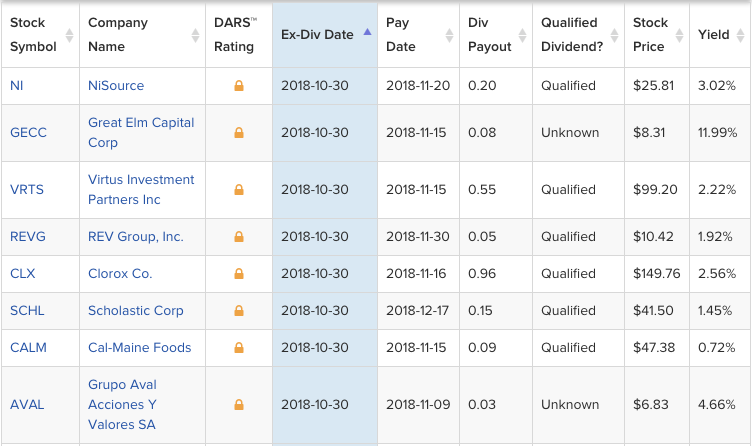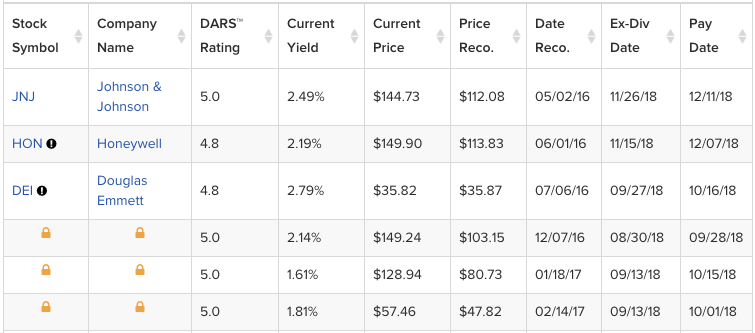Investing in dividend-paying stocks is a great way to build long-term wealth. Below, you’ll find introductory information about dividend stocks. In later sections, we will cover more advanced topics, such as dividend yield and dividend reinvestment programs.
How Do Dividends Work?
Essentially, for every share of a dividend stock that you own, you are paid a portion of the company’s earnings. You get paid simply for owning the stock!
For example, let’s say Company X pays an annualized dividend of 20 cents per share. Most companies pay dividends quarterly (four times a year), meaning at the end of every business quarter, the company will send a check for 1/4 of 20 cents (or 5 cents) for each share you own. This may not seem like a lot, but when you have built your portfolio up to thousands of shares, and use those dividends to buy more stock in the company, you can make a lot of money over the years. The key is to reinvest those dividends!
What are Cash Dividends and One-time Dividends?
Cash Dividends
Regular cash dividends are those paid out of a company’s profits to the owners of the business (i.e., the shareholders). A company that has preferred stock issued must make the dividend payment on those shares before a single penny can be paid out to the common stockholders.
Special One-Time Dividends
In addition to regular dividends, there are times a company may pay a special one-time dividend. These are rare and can occur for a variety of reasons such as a major litigation win, the sale of a business or liquidation of a investment. They can take the form of cash, stock or property dividends.
When Do Dividends Get Paid?
Dividends must be declared (i.e., approved) by a company’s Board of Directors each time they are paid. There are four important dates to remember regarding dividends.
- Declaration date: The declaration date is the day the Board of Directors announces their intention to pay a dividend. On this day, the company creates a liability on its books; it now owes the money to the stockholders. On the declaration date, the Board will also announce a date of record and a payment date.
- Date of record: The date of record is the date on which a company reviews its records to determine exactly who its shareholders are — an investor must be a “holder of record” in order to receive a dividend payout. A stock will almost always begin trading ex-dividend (or “ex-rights”) the second business day before the record date. In other words, only the owners of the shares on or before the ex-dividend date will receive the dividend. If you purchased shares of Coca-Cola on or after the ex-dividend date, you would not receive its upcoming dividend payment; the investor from whom you purchased your shares would.
- Ex-dividend Date: The ex-dividend date of a stock is the single most important date for dividend investors to consider. To receive a stock’s upcoming dividend, an investor must purchase shares of the stock prior to the ex-dividend date.
- Payment date: This is the date the dividend will actually be given to the shareholders of company.
Investors can use the Ex-Dividend Date Search tool to track stocks that are going ex-dividend during a specific date range. Ex-dividend dates are extremely important in dividend investing, because you must own a stock before its ex-dividend date in order to be eligible to receive its next dividend. Check out the below screenshot of the results for stocks going Ex-Dividend on October 30, 2018.

How Often are Dividends Paid?
The vast majority of dividends are paid four times a year on a quarterly basis, but some companies pay their dividends semi-annually (twice a year), annually (once a year), monthly, or more rarely, on no set schedule whatsoever (called “irregular” dividends).
For U.S. stocks in particular, there are no “set in stone” rules dictating the frequency of dividend payouts. That is to say, corporations have the freedom to set their own payout policies regarding both the size and timing of their distributions. With that being said, there is a tradition that most regular corporations will pay out a dividend to their shareholders on a quarterly basis, which aligns with the legal requirement to report earnings on a quarterly basis. Ultimately, the decision of how of often dividends will be paid out is left to a company’s board of directors.
In many countries outside of the United States, corporations will often times pay out a distribution on either an annual (once a year) or semi-annual (twice a year) basis; as mentioned previously, there are also a number of U.S. stocks that don’t follow the quarterly tradition, instead they too will make annual or semi-annual distributions to their shareholders.
See our complete list of Foreign Dividend Stocks »
There are other instances when securities will not stick to a quarterly dividend payout plan. More often than not, companies that are legally structured with the intent to generate a consistent distribution of income to shareholders will pay out dividends on a monthly basis; specifically, this includes many, but not all, real estate investment trusts as well as master-limited partnerships. These companies may be appealing to investors who require a more frequent stream of income.
What Exactly is a Stock Dividend?
A stock dividend is a proportionate distribution of additional shares of a company’s stock to owners of the common stock. In other words, you will receive additional shares of stock when a company declares a stock dividend, in contrast to a cash dividend. A company may opt for stock dividends for a number of reasons including inadequate cash on hand or a desire to lower the price of the stock on a per-share basis to prompt more trading and increase liquidity. The term “stock split” can also apply to stock dividends.
Key Lessons in This Chapter
- Dividends are a way that companies reward shareholders for owning the stock, usually in the form of a cash payment.
- Normally, companies pay cash dividends on a regular basis (often quarterly). Sometimes, they’ll elect to pay a one-time dividend, as well.
- Stock dividends are another type of payment that involve additional shares of stock instead of cash. These are also know as stock splits.
To view Dividend.com’s Highly Recommended list of stocks, be sure to check out our Best Dividend Stocks List. The list features Dividend.com’s top-rated dividend stocks, geared toward traditional long-term, buy-and-hold investors. All stocks on this list are rated using Dividend.com’s proprietary Dividend Advantage Rating System – DARS™. Refer the below screenshot of our partial list, which gets updated each week.

We generate a weekly report on a stock from our Best Dividend Stocks List. Check out a free sample report on Johnson & Johnson (JNJ ), in which we discuss how JNJ performs on the five metrics of our proprietary Dividend Advantage Rating System – DARS™.
Related Articles
- Dividend Investing 101
- Dividend Yield: Definition and Tips
- What is a Dividend Reinvestment Plan?
- Our List of the Best Dividend Stocks
Dividend.com’s tools help investors make sound investment decisions. Investors can narrow down their stock investment search by screening, comparing and analyzing the vast universe of dividend-paying stocks.





